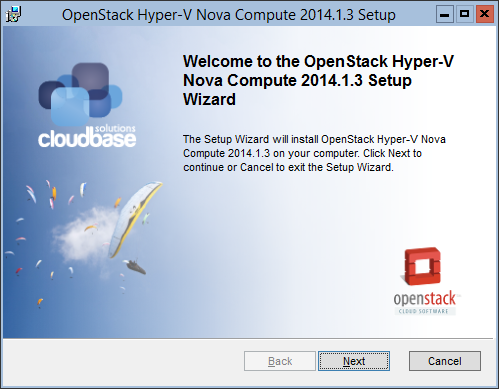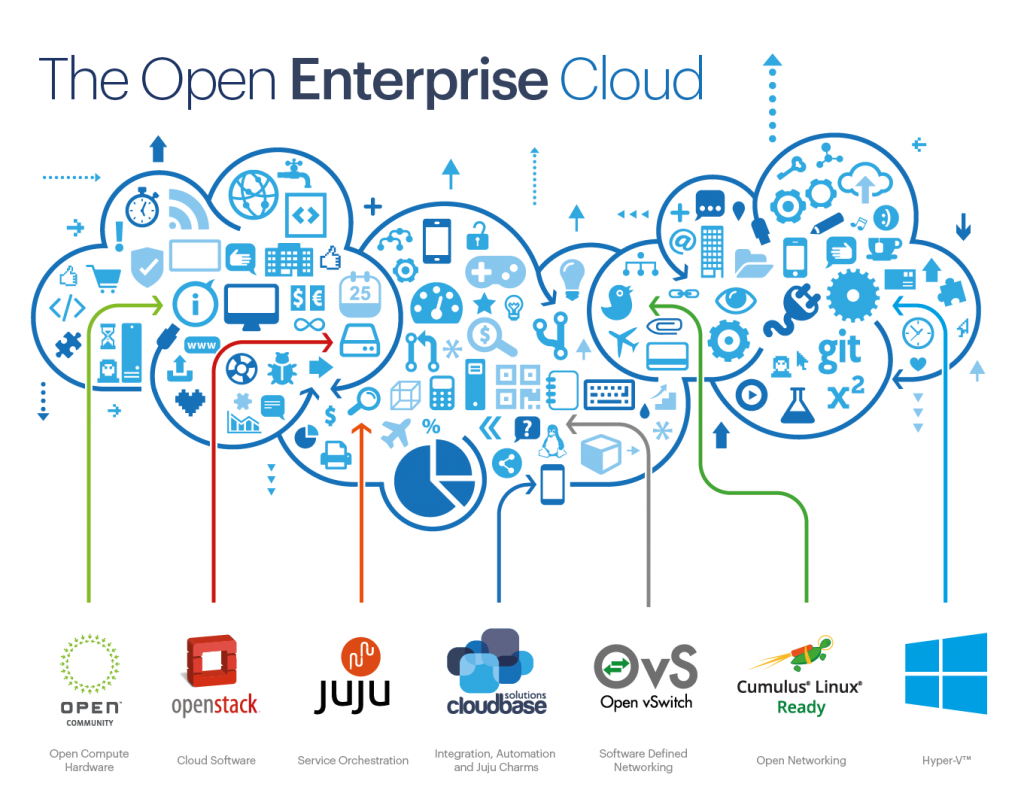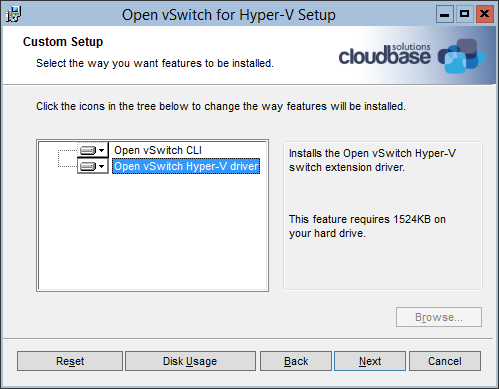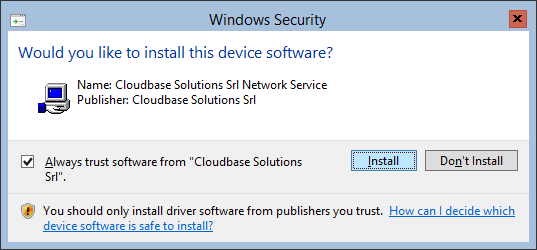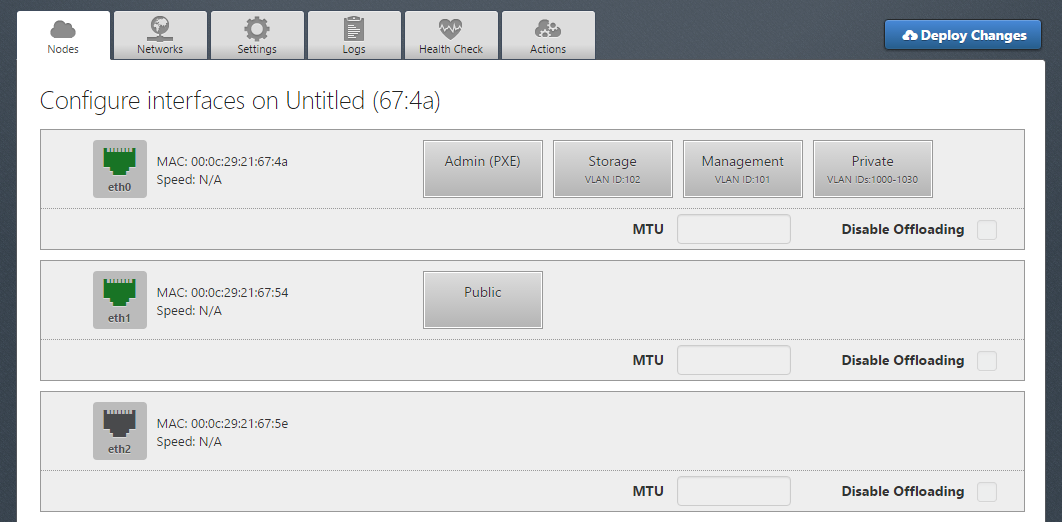In the previous article in this series we gave you a quick overview of why OpenStack and Windows Nano Server provide some of the most exciting elements in the current Windows ecosystem. In this article we are going to expand on those elements, and also give you the tools you need to deploy your own Hyper-Converged cloud using our OpenStack Windows Liberty components along with Ubuntu’s OpenStack Linux ones!
Why is everyone so excited about Windows Nano Server?
Nano Server is a new installation option for Windows Server 2016, reducing the overall footprint to just a few hundreds MB of disk space. The resulting deployed OS is thus way faster to deploy and to boot, reducing drastically also the overall amount of updates and reboots required during daily management. In short, it’s an OS built for a cloud age and huge leap forward compared to traditional GUI based Windows deployments.
Nano images are designed to be purpose built for each deployment. That means that if you want a Windows Server that is just a hypervisor, you can build the image just with that role installed and nothing else. In this article we are going to focus on three main roles:
- Compute (Cloudbase OpenStack components and Hyper-V)
- Clustering
- Storage (Storage Spaces Direct)
Storage Spaces Direct (S2D)
Aside from Nano itself, this is one of the features I am most excited about and a key element in allowing a hyper-converged scenario on Windows Server. Storage Spaces Direct is an evolution of Storage Spaces introduced in Windows Server 2012, with one important difference – it allows you to use locally attached storage. This means that you can use commodity hardware to build you own scale out storage at a fraction of the cost of a normal enterprise storage solution. This also means that we can create a hyper-converged setup where all Hyper-V compute nodes are clustered together and become bricks in a scale-out storage system.
![hyper-c-gfx]()
Ok, Ok…lets deploy already!
Before we begin, a word of warning. Windows Nano Server is in Technical Preview (it will be released as part of Windows Server 2016). The following deployment instructions have been tested and validated on the current Technical Preview 4 and subject to possible changes in the upcoming releases.
Prerequisites
We want to deploy an OpenStack cloud on bare metal. We will use Juju for orchestration and MaaS (Metal as a Service) as a bare metal provider. Here’s our requirements list. We kept the number of resources to the bare minimum, which means that some features, like full components redundancy are left for one of the next blog posts:
- MaaS install
- Windows Server 2016 TP4 ISO
- A Windows 10 or Windows Server 2016 installation. You will need this to build MaaS images.
- One host to be used for MaaS and controller related services
- Should have at least three NICs (management, data, external)
- At least 4 hosts that will be used as Hyper-V compute nodes
- Each compute node must have at least two disks
- Each compute node should have at least two NICs (management and data)
As an example, our typical lab environment uses Intel NUC servers. They are great for testing and have been our trusty companions throughout many demos and OpenStack summits. These are the new NUCs that have one mSATA port and an one M.2 port. We will use the M.2 disk as part of the storage spaces direct storage pool. Each NUC has one extra USB 3 ethernet NIC that acts as a data port.
Here’s a detailed list of the nodes configuration.
- Node 1
- Ubuntu 14.04 LTS MaaS on bare metal with 4 VMs running on KVM.
- 3 NICs, each one attached to a standard linux bridge.
-
- eth0 (attached to br0) is the MaaS publicly accessible NIC. It will be used by neutron as an external NIC.
- eth1 (attached to br1) is connected to an isolated physical switch. This will be the management port for nodes deployed using MaaS.
- eth2 (attached to br2) is connected to an isolated physical switch. This will be the data port used for tenant traffic.
- The MaaS node hosts 4 virtual machines:
- VM01
- tags: state
- purpose: this will be the Juju state machine
- NICs
- Minimum recommended resources:
- 2 CPU cores ( 1 should do as well)
- 2 GB RAM
- 20 GB disk space
- VM02
- tags: s2d-proxy
- purpose: This manages the Nano Server S2D cluster.
- NICs
- Minimum recommended resources:
- 2 CPU cores
- 2 GB RAM
- 20 GB disk
- VM03
- tags: services
- purpose: OpenStack controller
- NICs:
- eth0 attached to br1 (maas management)
- eth1 attached to br2 (isolated data port)
- eth3 attached to br0 (external network)
- Minimum recommended resources:
- 4 CPU cores
- 8 GB RAM
- 80 GB disk space
- VM04
- tags: addc
- purpose: Active Directory controller
- NICs:
- Minimum recommended resources:
- 2 CPU cores
- 2 GB RAM
- 20 GB disk
- Node 2,3,4,5
- each node has:
- 2 NICs available
- one NIC attached to the MaaS management switch (PXE booting must be enabled and set as first boot option)
- one NIC attached to the isolated data switch
- 2 physical disks (SATA, SAS, SSD)
- 16 GB RAM (recommended, minimum 4GB)
- tags: nano
- purpose: Nano Server Hyper-V compute nodes with Cloudbase OpenStack components
Install MaaS
We are not going to go into too much detail over this as the installation process has been very well documented in the official documentation. Just follow this article, it’s very simple and straightforward. Make sure to configure your management network for both DHCP and DNS. After installing MaaS, it’s time to register your nodes in MaaS. You can do so by simply powering them on once. MaaS will automatically enlist them.
You can log in the very simple and intuitive MaaS web UI available at http://<MaaS>/MAAS and check that you nodes are properly enlisted.
Assign tags to your MaaS nodes
Tags allow Juju to request hardware with specific requirements to MaaS for specific charms. For example the Nano Server nodes will have a “nano” tag. This is not necessary if your hardware is completely homogenous. We listed the tags in the prerequisite section.
This can be done either with the UI by editing each individual node or with the following Linux CLI instructions.
Register a tag with MaaS:
maas root tags new name='state'
And assign it to a node:
# <system_id> is the node's system ID. You can fetch it from MaaS
# using:
# maas root nodes list
# and usually has the form of:
# node-2e8f4d32-7859-11e5-8ee5-b8aeed71df42
# You can also get the ID of the node from the MaaS web ui by clicking on the node.
# The ID will be displayed in the browsers URL bar.
maas root tag update-nodes state add="<system_id>"
Build Windows images
After you have installed MaaS, we need to build Windows images. For this purpose, we have a set of PowerShell CmdLets that will aid you in building the images. Log into your Windows 10 / Windows Server 2016 machine and open an elevated PowerShell prompt.
First lets download some required packages:
# install Chocolatey package provider
Get-PackageProvider -Name chocolatey -ForceBootstrap
Set-PackageSource -Name Chocolatey -Trusted:$true
# Install Git
Install-Package -Source Chocolatey git
# Install Notepad++ (optional). Any other good editor will do as well.
Install-Package -Source Chocolatey notepadplusplus
# Add git to your path
$env:PATH += ";${env:ProgramFiles}\Git\cmd"
# check that git works
git --version
# If you wish to make the change to your $env:PATH permanent
# you can run:
# setx PATH $env:PATHDownload the required resources:
$ErrorActionPreference = "Stop"
mkdir $HOME\hyper-c -ErrorAction SilentlyContinue
cd $HOME\hyper-c
# Fetch scripts and commandlets
Invoke-WebRequest https://bit.ly/FastWebRequest -OutFile FastWebRequest.psm1
Import-Module .\FastWebRequest.psm1
Invoke-FastWebRequest -Uri "https://the.earth.li/~sgtatham/putty/latest/x86/pscp.exe"
Invoke-FastWebRequest -Uri "https://the.earth.li/~sgtatham/putty/latest/x86/putty.exe"
# Fetch nano image tools
git clone https://github.com/cloudbase/cloudbase-init-offline-install.git nano-image-tools
pushd nano-image-tools
git checkout nano-server-support
git submodule init
git submodule update
popd
# Fetch Windows imaging tools
git clone https://github.com/gabriel-samfira/windows-openstack-imaging-tools.git windows-imaging-tools
pushd windows-imaging-tools
git checkout experimental
popd
You should now have two extra folders in your home folder:
- generate-nano-image
- windows-openstack-imaging-tools-experimental
Generate the Nano image
Lets generate the Nano image first:
cd $HOME\hyper-c\nano-image-tools
# Change this to your actual ISO location
$isoPath = "$HOME\Downloads\Windows_Server_2016_Technical_Preview_4.ISO"
# This will be your default administrator password. Change this to whatever you prefer
$password = ConvertTo-SecureString -AsPlaintext -Force "P@ssw0rd"
# This is the path of your Nano baremetal image
$targetPath = "$HOME\DiskImages\Nano.raw.tgz"
# If your hardware needs extra drivers for NIC or storage, you can add it by
# passing the -ExtraDriversPaths option to the script.
.\NewNanoServerImage.ps1 -IsoPath $isoPath -TargetPath $targetPath `
-AdministratorPassword $password -Platform BareMetal `
-Compute -Storage -Clustering -MaxSize 1500MB `
-AddCloudbaseInit -AddMaaSHooks
cd ..
# Change to match you MaaS host address
$MAAS_HOST = "192.168.200.10"
# Copy the Nano image to the MaaS host, change the credentials accordingly
.\pscp.exe "$targetPath" "cloudbase@${MAAS_HOST}:"Now, SSH into your MaaS node and upload the image in MaaS using the following commands:
# Get your user's MAAS API key from the following URL: http://${MAAS_HOST}/MAAS/account/prefs/
# Note: the following assumes that your MaaS user is named "root", replace it as needed
maas login root http://${MAAS_HOST}/MAAS
# Upload image to MaaS
# At the time of this writing, MaaS was version 1.8 in the stable ppa
# Windows Server 2016 and Windows Nano support has been added in the next stable release.
# as such, the images we are uploading, will be "custom" images in MaaS. With version >= 1.9
# of MaaS, the name of the image will change from win2016nano to windows/win2016nano
# and the title will no longer be necessary
maas root boot-resources create name=win2016nano title="Windows Nano server" architecture=amd64/generic filetype=ddtgz content@=$HOME/Nano.raw.tgzThe name is important. It must be win2016nano. This is what juju expects when requesting the image from MaaS for deployment.
Generate a Windows Server 2016 image
This will generate a MaaS compatible image starting from a Windows ISO, it requires Hyper-V:
cd $HOME\hyper-c\windows-imaging-tools
# Mount Windows Server 2016 TP4 ISO
# Change path to actual ISO
$isoPath = $HOME\Downloads\WindowsServer2016TP4.iso
# Mount the ISO
$driveLetter = (Mount-DiskImage $isoPath -PassThru | Get-Volume).DriveLetter
$wimFilePath = "${driveLetter}:\sources\install.wim"
Import-Module .\WinImageBuilder.psm1
# Check what images are supported in this Windows ISO
$images = Get-WimFileImagesInfo -WimFilePath $wimFilePath
# Get the Windows images available in the ISO
$images | select ImageName
# Select the first one. Note: this will generate an image of Server Core.
# If you want a full GUI, or another image, choose from the list above
$image = $images[0]
$targetPath = "$HOME\DiskImages\Win2016.raw.tgz"
# Generate a Windows Server 2016 image, this will take some time!
# This requires Hyper-V for running the instance and installing Windows updates
# If your hardware needs extra drivers for NIC or storage, you can add it by
# passing the -ExtraDriversPath option to the script.
# You also have the option to install Windows Updates by passing in the -InstallUpdates option
New-MaaSImage -WimFilePath $wimFilePath -ImageName $image.ImageName `
-MaaSImagePath $targetPath -SizeBytes 20GB -Memory 2GB `
-CpuCores 2
cd ..
# Copy the Nano image to the MaaS host
.\pscp.exe "$targetPath" "cloudbase@${MAAS_HOST}:"Upload the image to MaaS:
# upload image to MaaS
# At the time of this writing, MaaS was version 1.8 in the stable ppa
# Windows Server 2016 and Windows Nano support has been added in the next stable release.
# as such, the images we are uploading, will be "custom" images in MaaS. With version >= 1.9
# of MaaS, the name of the image will change from win2016 to windows/win2016
# and the title will no longer be necessary
maas root boot-resources create name=win2016 title="Windows 2016 server" architecture=amd64/generic filetype=ddtgz content@=$HOME/Win2016.raw.tgz
As with the Nano image, the name is important. It must be win2016.
Setting up Juju
Now the fun stuff begins. We need to fetch the OpenStack Juju charms and juju-core binaries, and bootstrap the juju state machine. This process is a bit more involved, because it requires that you copy the agent tools on a web server (any will do). A simple solution is to just copy the tools to /var/www/html
For the juju deployment you will need to use an Ubuntu machine. We generally use the MaaS node directly in our demo setup, but if you are running Ubuntu already, you can use your local machine.
Fetch the charms and tools
For your convenience we have compiled a modified version of the agent tools and client binaries that you need to run on Nano Server. This is currently necessary as we’re still submitting upstream the patches for Nano Server support, so this step won’t be needed by the time Windows Server 2016 is released.
From your Ubuntu machine:
# install some dependencies
# add the juju stable ppa. We need this to get juju-deployer
sudo apt-add-repository -y ppa:juju/stable
# install packages
sudo apt-get update
sudo apt-get -y install unzip git juju-deployer
mkdir -p $HOME/hyper-c
cd $HOME/hyper-c
# Download juju-core with Nano support and the Hyper-C charms
git clone https://github.com/cloudbase/hyper-c.git hyper-c-master
wget "https://github.com/cloudbase/hyper-c/releases/download/hyper-c/juju-core.zip"
unzip juju-core.zip
# Add the client folder to the $PATH. You can make this change permanend
# for the current user by adding:
# export PATH="$HOME/hyper-c/juju-core/client:$PATH"
# to $HOME/.bashrc
export PATH="$HOME/hyper-c/juju-core/client:$PATH"
# test that the juju client is in your path
juju version
If everything worked as expected, the last command should give you the Juju version.
Configuring the Juju environment
If you look inside $HOME/hyper-c/juju-coretools
# NOTE: If you are following this article directly on your MAAS node,
# you can skip these steps
cd $HOME/hyper-c
scp -r $HOME/hyper-c/juju-core/tools cloudbase@$MAAS_HOST:~/
Now, ssh into your MaaS node and copy these files in a web accessible location:
sudo cp -a $HOME/hyper-c/juju-core/tools /var/www/html/
sudo chmod 755 -R /var/www/html/tools
Back on your client machine, create the juju environments boilerplate:
juju init
This will create a folder $HOME/.jujuenvironments.yaml
Edit the environments file:
nano $HOME/.juju/environments.yaml
We only care about the MaaS provider. You will need to navigate over to your MaaS server under http://${MAAS_HOST}/MAAS/account/prefs/
Replace your environments.yaml
default: maas
environments:
maas:
type: maas
# this is your MaaS node. Replace "MAAS_IP" with the actual hostname or IP
maas-server: 'http://MAAS_IP/MAAS/'
# This is where you uploaded the tools in the previous step. Replace "MAAS_IP" with actual hostname or IP
agent-metadata-url: "http://MAAS_IP/tools"
agent-stream: "released"
maas-oauth: 'maas_API_key'
# This will become you juju administrative user password
# you may use this password to log into the juju GUI
admin-secret: 'your_secret_here'
disable-network-management: false
bootstrap-timeout: 1800Before you bootstrap the environment, it’s important to know if the newly bootstrapped state machine will be reachable from your client machine. For example, If you have a lab environment where all your nodes are in a private network behind MaaS, where MaaS is also the router for the network it manages, you will need to do two things:
- enable NAT and ip_forward on your MaaS node
- create a static route entry on your client machine that uses the MaaS node as a gateway for the network you configured in MaaS for your cluster
Enable NAT on MaaS:
# enable MASQUARADE
# br0 publicly accessible interface
# br1 MaaS management interface (PXE for nodes)
/sbin/iptables -t nat -A POSTROUTING -o br0 -j MASQUERADE
/sbin/iptables -A FORWARD -i br0 -o br1 -m state --state RELATED,ESTABLISHED -j ACCEPT
/sbin/iptables -A FORWARD -i br1 -o br0 -j ACCEPT
# enable ip_forward
echo 'net.ipv4.ip_forward=1' >> /etc/sysctl.conf
sysctl -p
Add a static route on your client:
# $MAAS_HOST was defined above in the sections regarding image generation
# NOTE: this is not needed if you are running the juju client directly on your MaaS node
route add -net 192.168.2.0 255.255.255.0 gw $MAAS_HOST
You are now ready to bootstrap your environment:
# Adapt the tags constraint to your environment
juju bootstrap --debug --show-log --constraints tags=state
Deploy the charms
You should now have a fully functional juju environment with Windows Nano Server support. Time to deploy the charms!
This is the last step in the deployment process. For your convenience, we have made a bundle file available inside the repository. You can find it in:
$HOME/hyper-c/hyper-c-master/openstack.yaml
Make sure you edit the file and set whatever options applies to your environment. For example, the bundle file expects to find nodes with certain tags. Here is an example:
s2d-proxy:
num_units: 1
charm: local:win2016/s2d-proxy
branch: lp:cloudbaseit/s2d-proxy
options:
# Change this to an IP address that matches your environment.
# This IP address should be in the same network as the IP addresses
# you configured your MaaS cluster to assign to your nodes. Make sure
# that this IP cannot be allocated to any other node. This can be done
# by leaving a few IP addresses out of the static and dynamic ranges MaaS
# allocates from.
# For example: 192.168.2.10-192.168.2.100 where 192.168.2.0-192.168.2.9
# are left for you to decide where to allocate them.
static-address: 192.168.2.9
# change this tag to match a node you want to target
constraints: "tags=s2d-proxy"
nova-hyperv:
num_units: 4
charm: local:win2016nano/nova-hyperv
branch: lp:cloudbaseit/nova-hyperv
options:
use-bonding: false
# These are all the MAC addresses from all the nodes that are supposed to be
# used as data ports. You can find these ports in MaaS under node details
# Make sure you change this to match your environment.
data-port: "3c:18:a0:05:cd:1c 3c:18:a0:05:cd:07 3c:18:a0:05:cd:22 3c:18:a0:05:cd:1e"
network-type: "hyperv"
openstack-version: "liberty"
constraints: "tags=nano"Pay close attention to every definition in this file. It should precisely mirror your environment (tags, MAC addresses, IP addresses, etc). A misconfiguration will yield unpredictable results.
Use juju-deployer
cd $HOME/hyper-c/hyper-c-master
juju-deployer -L -S -c openstack.yaml
It will take a while for everything to run, so sit back and relax while your environment deploys. There is one more thing worth mentioning. Juju has a gorgeous web GUI. Its not resource intensive, so you can deploy it to your state machine. Simply:
juju deploy juju-gui --to 0
You will be able to access it using the IP of the state machine. To get the ip simply do:
juju status --format tabular
The user name will be adminadmin-secret
At the end of this you will have the following setup:
- Liberty OpenStack cloud (with Ubuntu and Cloudbase components)
- Active Directory controller
- Hyper-V compute nodes
- Storage Spaces Direct
Access your OpenStack environment
Get the IP of your Keystone endpoint
juju status --format tabular | grep keystone
Export the required OS_* variables (you can also put them in your .bashrc):
export OS_USERNAME=cbsdemo
export OS_PASSWORD=Passw0rd
export OS_TENANT_NAME=admin
export OS_AUTH_URL=http://<keysone_ip>:35357/v2.0/
# Let's list the Nova services, including the four Nano Server compute nodes
apt-get install python-novaclient -y
nova service-list
You can access also Horizon by fetching its IP from Juju and open it in your web browser:
juju status --format tabular | grep openstack-dashboard
What if something went wrong?
The great thing in automated deployments is that you can always destroy them and start over!
juju-deployer -TT -c openstack.yaml
Form here you can run again:
juju-deployer -L -S -c openstack.yaml
What’s next?
Stay tuned, in the next posts, we’ll show how to add Cinder volume on top of Storage Spaces Direct and how to easily add fault tolerance to your controller node (the Nano Server nodes are already fault tolerant).
You can also start deploying some great guest workload on top of your OpenStack cloud, like SQL Server, Active Directory, SharePoint, Exchange etc using our Juju charms!
I know this has been a long post, so if you managed to get this far, congratulations and thank you! We are curious to hear how you will use Nano Server and storage spaces direct!
The post Hyper-Converged OpenStack on Windows Nano Server – Part 2 appeared first on Cloudbase Solutions.

